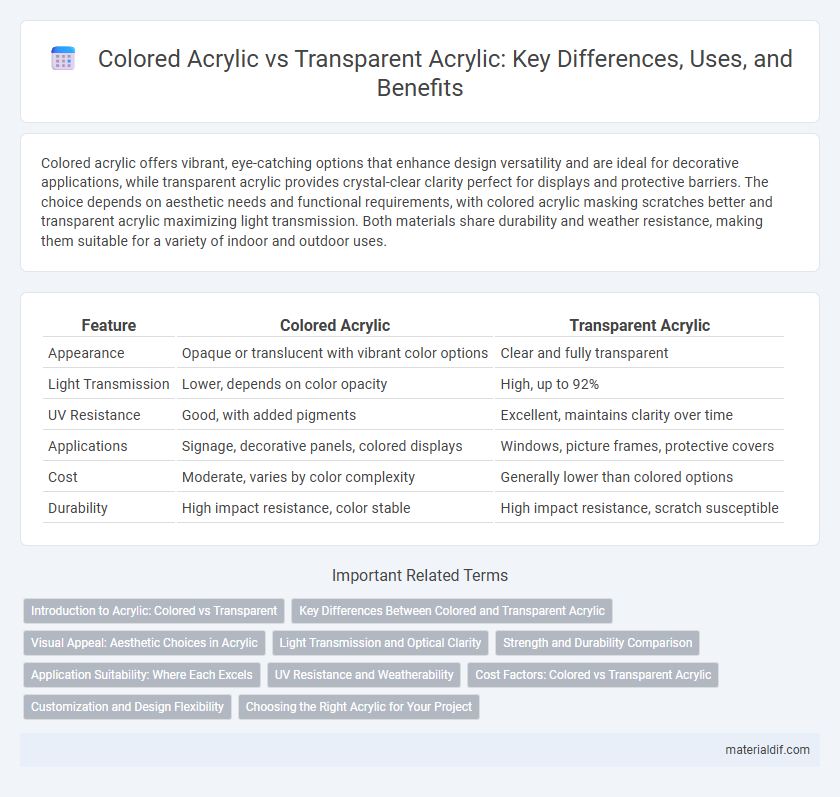Colored acrylic offers vibrant, eye-catching options that enhance design versatility and are ideal for decorative applications, while transparent acrylic provides crystal-clear clarity perfect for displays and protective barriers. The choice depends on aesthetic needs and functional requirements, with colored acrylic masking scratches better and transparent acrylic maximizing light transmission. Both materials share durability and weather resistance, making them suitable for a variety of indoor and outdoor uses.
Table of Comparison
| Feature | Colored Acrylic | Transparent Acrylic |
|---|---|---|
| Appearance | Opaque or translucent with vibrant color options | Clear and fully transparent |
| Light Transmission | Lower, depends on color opacity | High, up to 92% |
| UV Resistance | Good, with added pigments | Excellent, maintains clarity over time |
| Applications | Signage, decorative panels, colored displays | Windows, picture frames, protective covers |
| Cost | Moderate, varies by color complexity | Generally lower than colored options |
| Durability | High impact resistance, color stable | High impact resistance, scratch susceptible |
Introduction to Acrylic: Colored vs Transparent
Colored acrylic offers vibrant hues and enhanced design versatility for decorative and artistic applications, while transparent acrylic provides exceptional clarity and light transmission ideal for display cases and protective barriers. Both types share attributes such as high impact resistance, ease of fabrication, and weatherability, making them suitable for indoor and outdoor use. Choosing between colored and transparent acrylic depends on the desired aesthetic effect and functional requirements of the project.
Key Differences Between Colored and Transparent Acrylic
Colored acrylic offers vibrant hues that enhance aesthetic appeal and provide UV resistance, making it ideal for decorative applications, while transparent acrylic boasts superior clarity and light transmission, perfect for display cases and windows. Colored acrylic tends to absorb more heat and may slightly reduce light passage, whereas transparent acrylic maximizes visibility with minimal color distortion. Both types offer high impact resistance and durability, but selecting between colored and transparent acrylic depends on the specific requirements for appearance and light interaction in the project.
Visual Appeal: Aesthetic Choices in Acrylic
Colored acrylic offers vibrant hues and customizable shades that enhance design versatility, making it ideal for bold, eye-catching projects. Transparent acrylic provides clarity and a glass-like appearance, allowing natural light to pass through and creating a clean, modern aesthetic. Both options serve distinct visual purposes, with colored acrylic adding depth and personality, while transparent acrylic emphasizes openness and minimalism.
Light Transmission and Optical Clarity
Colored acrylic exhibits reduced light transmission compared to transparent acrylic, allowing only a portion of light to pass through due to its pigmentation. Transparent acrylic offers superior optical clarity with light transmission rates up to 92%, making it ideal for applications requiring clear visibility. The choice between colored and transparent acrylic depends on the desired balance between aesthetic appeal and light diffusion.
Strength and Durability Comparison
Colored acrylic exhibits enhanced UV resistance and maintains its strength longer when exposed to sunlight compared to transparent acrylic, which can yellow and become brittle over time. Both types offer high impact resistance, but transparent acrylic tends to have higher clarity and optical quality, making it preferable for applications requiring visibility. Durability-wise, colored acrylic resists scratches and environmental wear better, leading to longer lifespan in outdoor or harsh conditions.
Application Suitability: Where Each Excels
Colored acrylic excels in applications requiring enhanced visual impact and brand-specific aesthetics, commonly used in signage, displays, and decorative panels. Transparent acrylic is ideal for situations demanding clarity and light transmission, such as protective barriers, windows, and optical devices. Both types offer versatility, but choosing depends on whether color vibrancy or transparency is the priority.
UV Resistance and Weatherability
Colored acrylic offers superior UV resistance compared to transparent acrylic, effectively minimizing yellowing and surface degradation under prolonged sun exposure. Its enhanced weatherability makes it ideal for outdoor applications where color retention and structural integrity are crucial. Transparent acrylic, while visually clearer, tends to exhibit more rapid UV-induced aging and clouding without adequate protective coatings.
Cost Factors: Colored vs Transparent Acrylic
Colored acrylic typically incurs higher production costs than transparent acrylic due to the addition of pigments and dyes, which increase material expenses. Manufacturing colored acrylic involves more complex processing steps, leading to elevated labor and equipment costs compared to the straightforward production of transparent acrylic. Transparent acrylic remains more cost-effective for large-scale applications where color customization is unnecessary.
Customization and Design Flexibility
Colored acrylic offers extensive customization options with a wide range of vibrant hues and finishes, allowing designers to achieve specific aesthetic goals and brand consistency. Transparent acrylic provides unparalleled design flexibility by enabling light transmission and layering effects that enhance depth and visual interest in architectural and display applications. Both materials support cutting, shaping, and engraving techniques, but colored acrylic allows for more impactful visual statements, while transparent acrylic excels in clarity and light diffusion.
Choosing the Right Acrylic for Your Project
Colored acrylic offers vibrant hues that enhance visual appeal and provide UV protection, making it ideal for signage and decorative elements. Transparent acrylic excels in clarity and light transmission, perfect for display cases and protective barriers. Evaluating factors such as aesthetic requirements, light needs, and exposure conditions ensures selecting the right acrylic material for your project's success.
Colored Acrylic vs Transparent Acrylic Infographic

 materialdif.com
materialdif.com